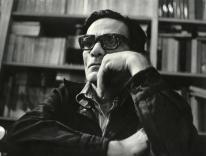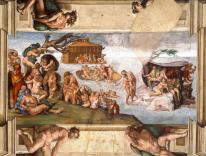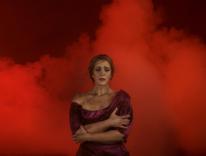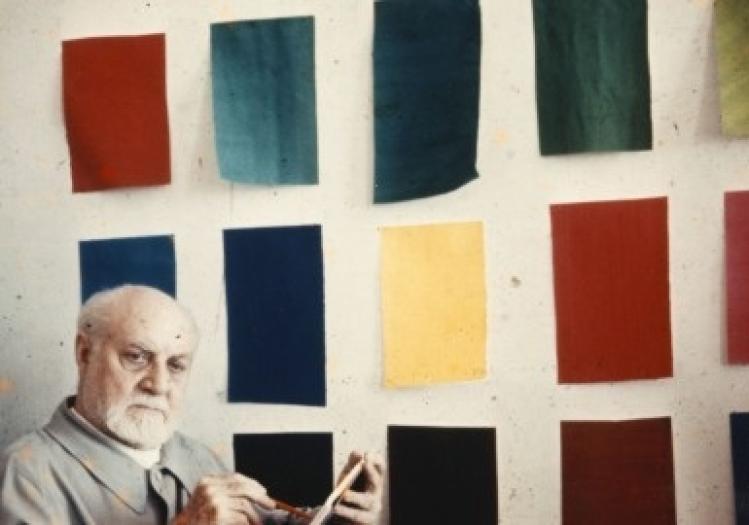
When the Museum of Modern Art held its grand retrospective of Henri Matisse in 1992, curated by John Elderfield, the exhibition climaxed with a high gallery of the artist's late cut-outs (or découpages). After learning in earlier galleries of Matisse's increasing debilitation after surgery for abdominal cancer in 1941, I remember vividly breaking into tears in the final gallery at the sight of the joyous, exuberant late works that showed the triumph of his indomitable spirit over his failing body. With the simplest of means--painted paper and a scissors--he had created a body of work whose curving forms in brilliant color sang of the bursting beauty of the world.
Now the cut-outs are back at the Modern, some one hundred in number as against fifty in 1992--and more transporting than ever. Organized by Karl Buchberg, Jodi Hauptman, and Samantha Friedman, the show also includes related drawings, illustrated books, stained glass, and textiles. I’ve seldom if ever heard so many visitors exclaiming, even gasping, with astonished pleasure and admiration at the sheer bliss of it all.
Matisse’s new form of art had a practical background. When commissioned by the collector Albert C. Barnes in 1930 to do a mural above the French doors of the main room in his new gallery in Merion, Pennsylvania, Matisse cut pieces of paper that he pinned to his canvas in order to revise the composition more easily. (A copy of his legendary painting “The Dance” of 1910 was on the wall as he worked on the Barnes mural, also known as “The Dance,” from 1932 to 1933.) Visiting Matisse at work, Léonide Massine asked for something similar for his new ballet Rouge et Noir at the Ballet Russe de Monte Carlo, and the first piece in the Modern’s show is a maquette for the stage curtain of that ballet (1937-38). On a deep blue ground, its two dancers, one in yellow and white leaping in the air and the other in black, are made with pieces of paper thumb-tacked together. Matisse used his new method in designing costumes for the ballet and a number of book covers as well.
An idea was emerging—without yet winning the artist’s full confidence. Matisse remembered, however, that Massine had been “captivated by the great dancing movement, the grand rhythm of [the Barnes] composition,” and when the Greek publisher Tériade persuaded him to design a book of “colored collages,” he turned his still tentative technique to great advantage. The result was Jazz, one of the most celebrated illustrated books of the 20th century (designed in 1943-44 and published in 1947), which teased cut paper into resplendent colored forms in motion: a white elephant balancing on a circus ball, a bucking horse and rider, the funeral procession of Pierrot, acrobats and a swimmer, the fall of Icarus. Even the three ravishing images of a lagoon show the water in full fluid flow.
Matisse, however, found the finished book, for all the care Tériade took in reproducing the gouache colors of the maquettes exactly, “absolutely a failure.” He missed the physical effect of the layered, cut paper and the depth it evoked. But he was learning something invaluable from the experience.
One summer day in 1946, as his assistant and secretary Lydia Delectorskaya recounts, he cut a white form in the shape of a swallow out of writing paper. Putting it up on his wall, he began to add other birds and forms of sea-life. Gradually the assemblage grew into two large pieces, “Oceania, the Sky” and “Oceania, the Sea,” that recalled his 1930 trip to Tahiti. The textile manufacturer Zika Ascher visited the apartment and suggested making them into silk-screens. White on beige, one of the thirty subsequent sets of screens look splendid at the Modern (where they are being shown for the first time in the United States). It was also in 1946, according to Delectorskaya, that Matisse made his first consciously cut-out piece, a small blue-on-white image of “The Lyre.”
Between 1943 and 1948 the artist lived and worked at the Villa le Rêve in Vence, where he began to use his cut-out style in abundance, having assistants paint large sheets of paper with intense gouache colors, then “cutting directly into [the] color,” as he put it—or “drawing with scissors,” to use another of his expressions—and using pins to attach the resulting forms on a paper ground. At first he worked on a board, then began to use the walls of the house as support, until soon he was entirely surrounded by luxuriant pieces that mixed representation and abstraction in seemingly endless variations. The Modern has partially recreated several of the walls and they are dazzling, at once dream-like and yet utterly concrete—images of sea algae and leaves, panels with one or the other and masks, a banner-like sequence of smaller panels that he teasingly called “Composition (The Velvets).” He thought he was resolving “the eternal conflict of drawing and color,” and whether in bed or in a wheelchair he did it with rhapsodic joy.
In Vence he was also approached by a Dominican nun who asked for advice about a chapel her community wanted to build. Matisse gradually undertook the design of the entire project—black on white tile images of the Stations of the Cross, Saint Dominic, and the Madonna and Child; windows for the nave and apse; and altar furnishings and vestments for the priests. The Modern shows the first two maquettes for the apse window, each more stunning than the other, and represents the final choice, “The Tree of Life,” with a trial for the window. When the Chapel of the Rosary was completed in 1951, after almost four years of work, the professedly non-believing artist said: “It is the result of all my active life. Despite all its imperfections, I consider it as my masterpiece.”
When he moved in 1949 to an apartment in the Hôtel Régina in Nice, where he lived until his death in 1954, the cut-outs grew larger and more ambitious. Commissioned in 1952 by Time magazine to do a maquette for a stained-glass window on a Christmas theme, he presented “Christmas Eve,” a tall lunette in which some of his typical organic forms build to the burst of an angular golden star at the top. The Modern owns both the maquette and the final window, and it is a revelation to compare their varying color values. In the same year he undertook a large series of cut-outs exclusively in ultramarine blue and white. A gallery at the heart of the show includes his four “Blue Nudes,” representing a sitting woman with her legs intertwined, her right arm reaching over her head, her left falling to her side. For “Blue Nude IV,” with which he began the series and finally ended it, he worked intensively for weeks, positioning and repositioning cut blue papers to represent parts of the body defined by the negative space between them. Once he mastered the process, we learn, he could do the next three nudes in fifteen to twenty minutes each, as in “Blue Nude II,” the most admired in the series. A similar though still more abstract approach appears in “The Swimming Pool,” his only large-scale, site-specific work, a fifty-four-foot continuous mural that he made for his dining room in the Hôtel Régina and that is shown at the Modern after five years of conservation in a room that reproduces exactly the dimensions of the Nice dining room. (On view for the first time since 1992, it was the occasion for mounting the current exhibition.)
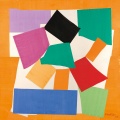 The last two galleries of the show contain work from 1952 and 1953, all of it larger (even immense, as in “Large Decoration with Two Masks”)--and sovereign. For a wealthy couple in California who wanted a ceramic for their patio, he started with the maquette “Large Decoration,” realized it was indeed too large, and made instead “The Sheaf,” “a vivid scatter of color on a white background,” as he himself described it, but with explosive centrifugal force. To make “a little garden all around me where I can walk,” he covered a corner of his apartment with the magical “The Parakeet and the Mermaid.” As a memorial for the deceased husband of Mary Lasker in Sleepy Hollow, New York, he designed “Ivy in Flower,” a three-on-three sash window overlooking blue and green leaves and red berries on a gold ground. And then, at the very end of the show, there is “The Snail” (above, left; image courtesy Museum of Modern Art), an almost perfectly abstract work in which torn pieces of brilliantly colored paper in lavender, violet, black, red, yellow, orange, blue, and shades of green swirl on a white ground framed in orange, echoing the spiral form of a snail’s shell and, as Delectorskaya put it, “the direction of universal movement.”
The last two galleries of the show contain work from 1952 and 1953, all of it larger (even immense, as in “Large Decoration with Two Masks”)--and sovereign. For a wealthy couple in California who wanted a ceramic for their patio, he started with the maquette “Large Decoration,” realized it was indeed too large, and made instead “The Sheaf,” “a vivid scatter of color on a white background,” as he himself described it, but with explosive centrifugal force. To make “a little garden all around me where I can walk,” he covered a corner of his apartment with the magical “The Parakeet and the Mermaid.” As a memorial for the deceased husband of Mary Lasker in Sleepy Hollow, New York, he designed “Ivy in Flower,” a three-on-three sash window overlooking blue and green leaves and red berries on a gold ground. And then, at the very end of the show, there is “The Snail” (above, left; image courtesy Museum of Modern Art), an almost perfectly abstract work in which torn pieces of brilliantly colored paper in lavender, violet, black, red, yellow, orange, blue, and shades of green swirl on a white ground framed in orange, echoing the spiral form of a snail’s shell and, as Delectorskaya put it, “the direction of universal movement.”
When Matisse first began his cut-outs, there were some who dismissed them as decorative self-indulgence. But growing praise for his new form of art followed his death. In 1942 he had told the writer Louis Aragon of his “unconscious belief in a future life…some paradise where I shall paint frescoes.” Now those frescoes, in cut-out form, enliven the vision of countless grateful viewers.
Please email comments to [email protected] and join the conversation on our Facebook page.
Share
Previous Story
Indian priest in Florida accused of obscenity involving a minor.
Next Story
Papal presser in the sky.
